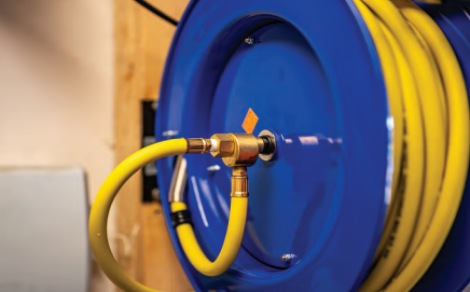- Home » Editorial » Hydraulics
Understanding and mitigating issues with hydraulic hose reels

H&P takes a snapshot look at the challenges and common issues associated with hydraulic hose reels and how to mitigate them.
Hydraulic hose reels play a vital role in various industries, providing a convenient and efficient way to manage and deploy hydraulic hoses. From construction sites to manufacturing facilities, these reels offer numerous benefits in terms of safety, organisation, and productivity.
Hydraulic hose reels are specialised devices designed to store, transport, and deploy hydraulic hoses safely and efficiently. These reels typically consist of a cylindrical drum around which the hydraulic hose is wound, a mechanism for winding and unwinding the hose, and various mounting options for installation.
The primary function of hydraulic hose reels is to prevent tangling, kinking, and damage to hoses, thus extending their lifespan and ensuring reliable performance. By keeping hoses neatly wound and protected from environmental elements, such as UV exposure, abrasion, and contaminants, hose reels contribute to maintaining the integrity of hydraulic systems. While hydraulic hose reels offer numerous benefits, they are not without their challenges. Here are some common challenges and issues that users may encounter:
1. Hose tangling and kinking: Improper winding or unwinding of hoses can lead to tangling and kinking, reducing the lifespan of the hoses and compromising their performance. It's essential to ensure proper installation and operation of the hose reel to minimize these issues.
2. Hose abrasion and damage: Repeated winding and unwinding of hoses, particularly in high-traffic areas or harsh environments, can cause abrasion and damage to the hose surface. Over time, this can lead to leaks, reduced flexibility, and premature failure of the hoses.
3. Hose overload: Exceeding the maximum capacity of the hose reel or using hoses that are too heavy for the reel can result in overloading. This can strain the reel's components, leading to premature wear and potential safety hazards. It's crucial to adhere to the manufacturer's specifications regarding hose capacity and weight limits.
4. Corrosion and environmental exposure: Hydraulic hose reels installed in outdoor or corrosive environments are susceptible to rust, corrosion, and degradation. Exposure to UV radiation, moisture, chemicals, and other contaminants can accelerate deterioration, compromising the integrity of the reel and the hoses stored within.
5. Maintenance and lubrication: Regular maintenance and lubrication are essential to ensure the smooth operation of hydraulic hose reels. Neglecting proper upkeep can result in stiffness, jamming, or malfunctioning of the reel mechanism, affecting productivity and safety.
Mitigating issues and best practices
To address these challenges and minimise the risk of issues with hydraulic hose reels, consider implementing the following best practices:
Proper installation and training: Ensure that hydraulic hose reels are installed correctly and securely mounted to prevent movement or instability. Provide adequate training to operators on the proper use and maintenance of the reels.
Regular inspection and maintenance: Conduct routine inspections of hose reels to check for signs of wear, damage, or corrosion. Replace worn or damaged components promptly, and lubricate moving parts as recommended by the manufacturer.
Hose protection and outing: Use protective covers or sleeves to shield hoses from abrasion, UV exposure, and environmental hazards. Properly route hoses to minimize sharp bends, twists, or obstructions that can lead to tangling or kinking.
Adherence to specifications: Follow the manufacturer's guidelines and specifications regarding hose compatibility, weight capacity, and operating conditions. Avoid overloading hose reels or using hoses that exceed their recommended limits.
By addressing these challenges and adopting best practices, users can maximise the performance, longevity, and safety of hydraulic hose reels in their operations. Despite these potential issues, the benefits of hydraulic hose reels in terms of safety, organisation, and productivity far outweigh the challenges when properly managed and maintained.
-
SMART Manufacturing & Engineering Week
04 - 05 June, 2025
NEC, Birmingham UK -
PPMA 2025
23 September, 2025, 9:30 - 25 September, 2025, 16:00
NEC, Birmingham UK -
Advanced Engineering Show 2025
29 October, 2025, 9:00 - 30 October, 2025, 16:00
NEC, Birmingham UK










